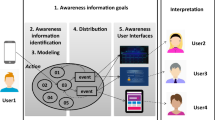Abstract
Supporting awareness of others is an idea that holds promise forimproving the usability of real-time distributed groupware.However, there is little principled information available aboutawareness that can be used by groupware designers. In thisarticle, we develop a descriptive theory of awareness for thepurpose of aiding groupware design, focusing on one kind of groupawareness called workspace awareness. We focus on how smallgroups perform generation and execution tasks in medium-sizedshared workspaces – tasks where group members frequently shiftbetween individual and shared activities during the work session.We have built a three-part framework that examines the concept ofworkspace awareness and that helps designers understand theconcept for purposes of designing awareness support in groupware.The framework sets out elements of knowledge that make upworkspace awareness, perceptual mechanisms used to maintainawareness, and the ways that people use workspace awareness incollaboration. The framework also organizes previous research onawareness and extends it to provide designers with a vocabularyand a set of ground rules for analysing work situations, forcomparing awareness devices, and for explaining evaluationresults. The basic structure of the theory can be used todescribe other kinds of awareness that are important to theusability of groupware.
Similar content being viewed by others
References
Ackerman, M. and B. Starr (1995): Social Activity Indicators: Interface Components for CSCW Systems. Proceedings of the ACM Symposium on User Interface Software and Technology, pp. 159–168.
Adams, M., Y. Tenney and R. Pew (1995): Situation Awareness and the Cognitive Management of Complex Systems. Human Factors, vol. 37, no. 1, pp. 85–104.
Baecker, R., D. Nastos, I. Posner and K. Mawby (1993): The User-Centred Iterative Design of CollaborativeWriting Software. Proceedings of the Conference on Human Factors in Computing Systems, Amsterdam, pp. 399–405.
Beaudouin-Lafon, M. and A. Karsenty (1992): Transparency and Awareness in a Real-Time Groupware System. Proceedings of the Conference on User Interface and Software Technology, Monterey, CA, pp. 171–180.
Benford, S., J. Bowers, L. Fahlen, C. Greenhalgh and D. Snowdon (1995): User Embodiment in Collaborative Virtual Environments. Proceedings of the Conference on Human Factors in Computing Systems (CHI'95), pp. 242–249.
Birdwhistell, Ray L. (1952): Introduction to Kinesics: An Annotation System for Analysis of Body Motion and Gesture. University of Kentucky Press.
Borning, A. and M. Travers (1991): Two Approaches to Casual Interaction over Computer and Video Networks. Proceedings of the Conference on Human Factors in Computing Systems, New Orleans, LA, pp. 13–19.
Brennan, S. (1990): Seeking and Providing Evidence for Mutual Understanding. Ph.D. thesis, Stanford University, Stanford, CA.
Brinck, T. and L.M. Gomez (1992): A Collaborative Medium for the Support of Conversational Props. Proceedings of Proceedings of the ACM Conference on Computer Supported Cooperative Work (CSCW'92), Toronto, Ontario, pp. 171–178.
Clark, H. (1996): Using Language. Cambridge: Cambridge University Press.
Clark, H.H. and S.E. Brennan (1991): Grounding in Communication. In R.M. Baecker (ed.): Readings in Groupware and Computer Supported Cooperative Work: Assisting Human-Human Collaboration. Mountain View, CA: Morgan-Kaufmann Publishers, pp. 222–233.
Dix, A., J. Finlay, G. Abowd and R. Beale (1993): Human-Computer Interaction. Prentice Hall.
Dewan, P. and R. Choudhary (1991): Flexible User Interface Coupling in a Collaborative System. Proceedings of CHI'91, pp. 41–48.
Dourish, P. and V. Bellotti (1992): Awareness and Coordination in Shared Workspaces. Proceedings of the Conference on Computer-Supported Cooperative Work, Toronto, pp. 107–114.
Dourish, P. and S. Bly (1992): Portholes: Supporting Awareness in a Distributed Work Group. Proceedings of the Conference on Human Factors in Computing Systems, Monterey, CA, pp. 541–547.
Ellis, C., S. Gibbs and G. Rein (1991): Groupware: Some Issues and Experiences. Communications of the ACM, vol. 34, no. 1, pp. 38–58.
Endsley, M. (1995): Toward a Theory of Situation Awareness in Dynamic Systems. Human Factors, vol. 37, no. 1, pp. 32–64.
Gaba, D., S. Howard and S. Small (1995): Situation Awareness in Anesthesiology. Human Factors, vol. 37, no. 1, pp. 20–31.
Gaver,W. (1991): Sound Support for Collaboration. Proceedings of the Second European Conference on Computer Supported Cooperative Work, pp. 293–308.
Gilson, R.D. (1995): Introduction to the Special Issue on Situation Awareness. Human Factors, vol. 37, no. 1, pp. 3–4.
Goodwin, C. (1981): Conversational Organization: Interaction Between Speakers and Hearers. New York: Academic Press.
Greenberg, S. and R. Bohnet (1991): GroupSketch: A Multi-User Sketchpad for Geographically-Distributed Small Groups. Proceedings of Proceedings of Graphics Interface' 91. Calgary, Alberta.
Greenberg, S. (1996): Peepholes: Low Cost Awareness of One's Community. Proceedings of the Conference on Human Factors in Computing Systems (Conference Companion). Vancouver, pp. 206–207.
Greenberg, S. and D. Marwood (1994): Real Time Groupware as a Distributed System: Concurrency Control and its Effect on the Interface. Proceedings of the Conference on Computer-Supported Cooperative Work. Chapel Hill NC, pp. 207–217.
Gutwin, C. (2000): Slow and Sticky: Effects of Network Delay on Real-Time Groupware. Technical Report 2000-02, Department of Computer Science, University of Saskatchewan.
Gutwin, C., S. Greenberg and A. Cockburn (1996): Using Distortion-Oriented Displays to Support Workspace Awareness. Proceedings of People and Computers XI (BCSHCI'96). London, pp. 299–314.
Gutwin, C., S. Greenberg and M. Roseman (1996): Workspace Awareness in Real-Time Distributed Groupware: Framework, Widgets, and Evaluation. In R.J. Sasse, A. Cunningham and R. Winder (eds.): People and Computers XI (Proceedings of the HCI'96). Springer-Verlag, pp. 281–298.
Gutwin, C. and S. Greenberg (1996): Workspace Awareness for Groupware. Proceedings of the Conference on Human Factors in Computing Systems. Vancouver, pp. 208–209.
Gutwin, C., S. Greenberg and M. Roseman (1996): Workspace Awareness in Real-Time Distributed Groupware: Framework, Widgets, and Evaluation. People and Computers XI (Proceedings of HCI'96). Springer-Verlag, pp. 281–298.
Gutwin, C., M. Roseman and S. Greenberg (1996): A Usability Study of Awareness Widgets in a Shared Workspace Groupware System. Proceedings of the Conference on Computer-Supported Cooperative Work. Boston, pp. 258–267.
Gutwin, C. and S. Greenberg (1998a): Effects of Awareness Support on Groupware Usability. Proceedings of ACM CHI'98. ACM Pres: Los Angeles.
Gutwin, C. and S. Greenberg (1998b): Design for Individuals, Design for Groups: Tradeoffs between Power and Workspace Awareness. Proceedings of ACM CSCW'98. ACM Press: Seattle.
Hall, E. (1959): The Silent Language. Doubleday.
Hayne, S., M. Pendergast and S. Greenberg (1993): Gesturing Through Cursors: Implementing Multiple Pointers in Group Supports Systems. In Proceedings of the HICSS Hawaii International Conference on System Sciences. IEEE Press.
Heath, C., M. Jirotka, P. Luff and J. Hindmarsh (1995): Unpacking Collaboration: The Interactional Organisation of Trading in a City Dealing Room. Computer Supported Cooperative Work, vol. 3, no. 2, pp. 147–165.
Heath, C. and P. Luff (1992): Collaboration and Control: Crisis Management and Multimedia Technology in London Underground Line Control Rooms. Computer-Supported Cooperative Work, vol. 1, nos. 1–2, pp. 69–94.
Hutchins, E. (1990): The Technology of Team Navigation. In J. Galegher, R. Kraut and C. Egido (eds.): Intellectual Teamwork: Social and Technological Foundations of Cooperative Work. Hillsdale, NJ: Lawrence Erlbaum, pp. 191–220.
Ishii, H. and M. Kobayashi (1992): ClearBoard: A Seamless Medium for Shared Drawing and Conversation with Eye Contact. Proceedings of the Conference on Human Factors in Computing Systems. Monterey, CA, pp. 525–532.
James,W. (1981 [written 1890]): The Principles of Psychology. Cambridge, MA: Harvard University Press.
Krauss, R. and S. Fussell (1997): Mutual Knowledge and Communicative Effectiveness. In J. Galegher, R. Kraut and C. Egido (eds.): Intellectual Teamwork: Social and Technological Foundations of Cooperative Work. Hillsdale, NJ: Lawrence Erlbaum, pp. 111–145.
McDaniel, S.E. and T. Brinck (1997): Awareness in Collaborative Systems. Workshop Report. SIGCHI Bulletin, October.
McGrath, J., (1984): Groups: Interaction and Performance. Englewood Cliffs, NJ: Prentice-Hall.
Mitchell, A. (1996): Communication and Shared Understanding in Collaborative Writing. M.Sc. thesis, University of Toronto, Toronto.
Neisser, U. (1976): Cognition and Reality. San Fransisco: W.H. Freeman.
Norman, D. (1993): Things That Make Us Smart. Reading, MA: Addison-Wesley.
Robinson, M. (1991): Computer-Supported Cooperative Work: Cases and Concepts. Proceedings of Groupware' 91, pp. 59–75.
Rodden, T. (1996): Populating the Application: AModel of Awareness for Cooperative Applications. Proceedings of ACM CSCW'96 Conference on Computer-Supported Cooperative Work, pp. 87–96.
Roseman, M. and S. Greenberg (1996): Building Real-Time Groupware with GroupKit, a Groupware Toolkit. Transactions on Computer-Human Interaction, vol. 3, no. 1, pp. 66–106.
Roseman, M. and S. Greenberg (1996): TeamRooms: Network Places for Collaboration. Proceedings of the Conference on Computer-Supported Cooperative Work. Boston.
Salas, E., C. Prince, D. Baker and L. Shrestha (1995): Situation Awareness in Team Performance: Implications for Measurement and Training. Human Factors, vol. 37, no. 1, pp. 123–136.
Salvador, T., J. Scholtz and J. Larson (1996): The Denver Model for Groupware Design. SIGCHI Bulletin, vol. 28, no. 1, pp. 52–58.
Sarter, N. and D. Woods (1995): How in the World Did We Ever Get into That Mode? Mode Error and Awareness in Supervisory Control. Human Factors, vol. 37, no. 1, pp. 5–19.
Seely Brown, J., A. Collins and P. Duguid (1989): Situated Cognition and the Culture of Learning. Educational Researcher (January–February), pp. 32–42.
Segal, L. (1994): Effects of Checklist Interface on Non-Verbal Crew Communications, NASA Ames Research Center, Contractor Report 177639.
Segal, L. (1995): Designing Team Workstations: The Choreography of Teamwork. In P. Hancock, J. Flach, J. Caird and K. Vicente (eds.): Local Applications of the Ecological Approach to Human-Machine Systems. Hillsdale, NJ: Lawrence Erlbaum, pp. 392–415.
Short, J., E. Williams and B. Christie (1976): Communication Modes and Task Performance. In R.M. Baecker (ed.): Readings in Groupware and Computer Supported Cooperative Work: Assisting Human-Human Collaboration. Mountain View, CA: Morgan-Kaufmann Publishers, pp. 169–176.
Smith, K. and P. Hancock (1995): Situation Awareness is Adaptive, Externally Directed Consciousness. Human Factors, vol. 37, no. 1, pp. 137–148.
Smith, R. (1999): The Kansas Project. http://www.sun.com/research/ics/kansas.html.
Smith, R., R. Hixon and B. Horan (1998): Supporting Flexible Roles in a Shared Space. Proceedings of ACM CSCW'98 Conference on Computer-Supported Cooperative Work, pp. 197–206.
Sohlenkamp, M. and G. Chwelos (1994): Integrating Communication, Cooperation and Awareness: The DIVA Virtual Office Environment. Proceedings of ACMCSCW'94 Conference on Computer-Supported Cooperative Work, pp. 331–343.
Stefik, M., G. Foster, D. Bobrow, K. Kahn, S. Lanning and L. Suchman (1987a): Beyond the Chalkboard: Computer Support for Collaboration and Problem Solving in Meetings. Communications of the ACM, vol. 30, no. 1, pp. 32–47.
Stefik, M., D. Bobrow, G. Foster, S. Lanning and D. Tatar (1987b): WYSIWIS Revised: Early Experiences with Multiuser Interfaces. ACM Transactions on Office Information Systems, vol. 5, no. 2, pp. 147–167.
Tang, J. (1989): Listing, Drawing, and Gesturing in Design: A Study of the Use of Shared Workspaces by Design Teams. Ph.D. thesis, Stanford University, Stanford, CA.
Tang, J. (1991): Findings from Observational Studies of Collaborative Work. International Journal of Man-Machine Studies, vol. 34, no. 2, pp. 143–160.
Tatar, D., G. Foster and D. Bobrow (1991): Design for Conversation: Lessons from Cognoter. International Journal of Man-Machine Studies, vol. 34, no. 2, pp. 185–210.
Tang, J.C. and S.L. Minneman (1991): VideoWhiteboard: Video shadows to support remote collaboration. Proceedings of ACM SIGCHI Conference on Human Factors in Computing Systems, New Orleans, pp. 315–322.
Watts, J., D. Woods, J. Corban, E. Patterson, R. Kerr and L. Hicks (1996): Voice Loops as Cooperative Aids in Space ShuttleMission Control. Proceedings of ACMCSCW'96 Conference on Computer-Supported Cooperative Work, pp. 48–56.
Author information
Authors and Affiliations
Rights and permissions
About this article
Cite this article
Gutwin, C., Greenberg, S. A Descriptive Framework of Workspace Awareness for Real-Time Groupware. Computer Supported Cooperative Work (CSCW) 11, 411–446 (2002). https://doi.org/10.1023/A:1021271517844
Issue Date:
DOI: https://doi.org/10.1023/A:1021271517844




